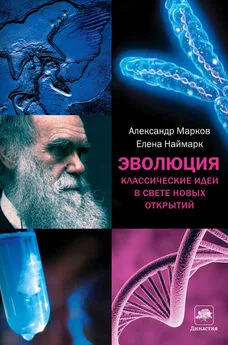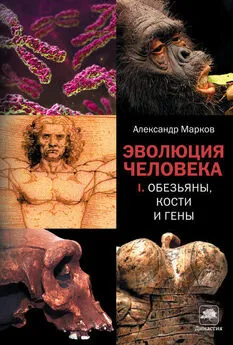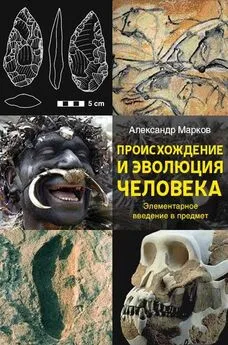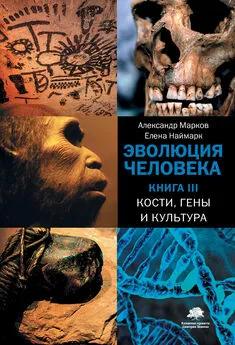Александр Марков - Эволюция. Классические идеи в свете новых открытий
- Название:Эволюция. Классические идеи в свете новых открытий
- Автор:
- Жанр:
- Издательство:АСТ: CORPUS
- Год:2014
- Город:Москва
- ISBN:978-5-17-083218-7
- Рейтинг:
- Избранное:Добавить в избранное
-
Отзывы:
-
Ваша оценка:
Александр Марков - Эволюция. Классические идеи в свете новых открытий краткое содержание
Книга Александра Маркова и Елены Наймарк рассказывает о новейших исследованиях молекулярных генетиков и находках палеонтологов, которые дают ответы на эти и многие другие вопросы о видоизменениях в природе. Тысячи открытий, совершенных со времен Дарвина, подтверждают догадки родоначальников теории эволюции; новые данные ничуть не разрушают основы эволюционной теории, а напротив, лишь укрепляют их.
Александр Марков, заведующий кафедрой биологической эволюции биофака МГУ, и Елена Наймарк, ведущий научный сотрудник Палеонтологического института им. А. А. Борисяка, — известные ученые и популяризаторы науки. Двухтомник «Эволюция человека» (2011), написанный ими в соавторстве, стал настольной книгой не только для студентов и ученых-биологов, но и для множества людей за пределами профессионального сообщества.
Эволюция. Классические идеи в свете новых открытий - читать онлайн бесплатно ознакомительный отрывок
Интервал:
Закладка:
Matute D. R., Butler I. A., Turissini D. A., Coyne J. A. 2010. A test of the snowball theory for the rate of evolution of hybrid incompatibilities // Science. V.329. P. 1518–1521.
Mayr E. 1942. Systematics and the origin of species . New York: Columbia University Press.
Mayer W. E., Schuster L. N., Bartelmes G., et al. 2011. Horizontal gene transfer of microbial cellulases into nematode genomes is associated with functional assimilation and gene turnover // BMC Evolutionary Biology. V. 11. P. 13.
Maynard Smith J. 1970. Natural selection and the concept of a protein space // Nature. V. 225. P. 563–564.
McGrath P. T., Xu Y., Ailion M., et al. 2011. Parallel evolution of domesticated Caenorhabditis species targets pheromone receptor genes // Nature. V. 477. P. 321–325.
Meng J., Wang Y., Li C. 2011. Transitional mammalian middle ear from a new Cretaceous Jehol eutriconodont // Nature. V. 472. P. 181–185.
Milinski M., Griffiths S., Wegner K. M., et al. 2005. Mate choice decisions of stickleback females predictably modified by MHC peptide ligands // Proc. Nat. Acad. Sci. USA. V. 102. P. 4414–4418.
Miller W. J., Ehrman L., Schneider D. 2010. Infectious speciation revisited: impact of symbiont-depletion on female fitness and mating behavior of Drosophila paulistorum // PLoS Pathogens. V. 6. P. e1001214.
Molina J., Sikorab М., Garud N., et al. 2011. Molecular evidence for a single evolutionary origin of domesticated rice // Proc. Nat. Acad. Sci. USA. V. 108. P. 8351–8356.
Moran N. A., Jarvik T. 2010. Lateral transfer of genes from fungi underlies carotenoid production in aphids // Science. V. 328. P. 624–627.
Morran L. T., Parmenter М. D., Phillips P. C. 2009. Mutation load and rapid adaptation favour outcrossing over self-fertilization // Nature. V. 462. P. 350352.
Morran L. T., Schmidt O. G., Gelarden I. A., et al. 2011. Running with the Red Queen: host-parasite coevolution selects for biparental sex // Science. V.333. P. 216–218.
Moyle L. C., Nakazato T. 2010. Hybrid incompatibility “snowballs” between Solanum species // Science. V. 329. P. 1521–1523.
Näsvall J., Sun L., Roth J. R., Andersson D. I. 2012. Real-time evolution of new genes by innovation, amplification, and divergence // Science. V. 338.
P. 384–387.
Niedźwiedzki G., Szrek P., Narkiewicz K., et al. 2010. Tetrapod trackways from the early Middle Devonian period of Poland // Nature. V. 463. P. 43–48.
Nikoh N., Nakabachi A. 2009. Aphids acquired symbiotic genes via lateral gene transfer // BMC Biology. V. 7. P. 12.
Nombela J. J. A., Murcia C. R., Abaigar T., Vericad J. R. 1990. Cytogenetic analysis (GTG, CBG and NOR bands) of a wild boar population (Sus scrofa scrofa) with chromosomal polymorphism in the south-east of Spain // Genetics, Selection, Evolution. V. 22. P. 1–9.
Ohno S. 1970. Evolution by gene duplication . New York, Heidelberg, Berlin: Springer-Verlag.
Oliveira A. K., Cordeiro A. R. 1980. Adaptation of Drosophila willistoni experimental populations to extreme pH medium II. Development of incipient reproductive isolation // Heredity. V. 44. P. 123–130.
Oliver K. М., Degnan P. H., Hunter М. S., Moran N. A. 2009. Bacteriophages encode factors required for protection in a symbiotic mutualism // Science. V. 325. P. 992–994.
Organ С. L., Shedlock A. M., Meade A., et al. 2007. Origin of avian genome size and structure in non-avian dinosaurs // Nature. V. 446. P. 180–184.
Orr H. A., Masly J. P., Presgraves D. С. 2004. Speciation genes // Current Opinion in Genetics & Development. V. 14. P. 675–679.
Ortenberg R., Tchlet R., Mevarech M. 1998. A model for the genetic exchange system of the extremely halophilic archaeon Haloferax volcanii // In: A. Oren, ed. Microbiology and biogeochemistry of hypersaline environments . CRC Press. P. 331–338.
Otto S. P., Whitton J. 2000. Polyploid incidence and evolution // Annual Review of Genetics. V. 34. P. 401–437.
Paegel B. M., Joyce G. F. 2008. Darwinian evolution on a chip // PLoS Biology. V. 6 (4). P. e85.
Pagel M., Atkinson Q. D., Meade A. 2007. Frequency of word-use predicts rates of lexical evolution throughout Indo-European history // Nature. V. 449. P. 717–720.
Papke R. Т., Koenig J. E., Rodríguez-Valera F., Doolittle W. F. 2004. Frequent recombination in a saltern population of Halorubrum // Science. V.306. P. 1928–1929.
Paterson S., Vogwill Т., Buckling A., et al. 2010. Antagonistic coevolution accelerates molecular evolution // Nature. V. 464. P. 275–278.
Patthy L. 1999. Genome evolution and the evolution of exon-shuffling — a review // Gene. V. 238. P. 103–114.
Peisajovich S. G., Garbarino J. E., Wei P., Lim W. A. 2010. Rapid diversification of cell signaling phenotypes by modular domain recombination // Science. V. 328. P. 368–372.
Pfennig К. S. 2007. Facultative mate choice drives adaptive hybridization // Science. V. 318. P. 965–967.
Pollinger J. P., Bustamante С. D., Fledel-Alon A., et. al. 2005. Selective sweep mapping of genes with large phenotypic effects // Genome Research. V.15. P. 1809–1819.
PovoloTskaya I. S., Kondrashov F. A. 2010. Sequence space and the ongoing expansion of the protein universe // Nature. V. 465. P. 922–926.
Pryke S. R., Griffith S. С. 2009. Genetic incompatibility drives sex allocation and maternal investment in a polymorphic finch // Science. V. 323. P. 1605–1607.
Putnam N. Н., Butts T., Ferrier D. E. K., et al. 2008. The Amphioxus genome and the evolution of the chordate karyotype // Nature. V. 453. P. 1064–1071.
Pylkov K. V., Zhivotovsky L. A., Feldman М. W 1998. Migration versus mutation in the evolution of recombination under multilocus selection // Genet. Res. V.71 (3). P. 247–256.
Queitsch C., Sangster T. A., Lindquist S. 2002. Hsp90 as a capacitor of phenotypic variation // Nature. V. 417. P. 618–624.
Rabosky D. L., McCune A. R. 2010. Reinventing species selection with molecular phylogenies // Trends Ecol. Evol. V. 25. P. 68–74.
Raj A., Rifkin S. A., Andersen E., van Oudenaarden A. 2010. Variability in gene expression underlies incomplete penetrance // Nature. V. 463. P. 913–918.
Rajakumar R., San Mauro D., Dijkstra М. B., et al. 2012. Ancestral developmental potential facilitates parallel evolution in ants // Science. V. 335. P. 79–82.
Ratcliff W. C., Denison R. F., Borrello М., Travisano М. 2012. Experimental evolution of multicellularity // Proc. Nat. Acad. Sci. USA. V. 109. P. 1595–1600.
Rea S. L., Wu D., Cypser J. R., et al. 2005. A stress-sensitive reporter predicts longevity in isogenic populations of Caenorhabditis elegans // Nature Genetics. V.37. P. 894–898.
Reed R. D., Papa R., Martin A., et al. 2011. optix drives the repeated convergent evolution of butterfly wing pattern mimicry // Science. V. 333. P. 11371141.
Reznick D. N., Ghalambor C. K. 2005. Selection in nature: Eхperlmental manipulations of natural populations // Integrative and Comparative Biology. V. 45. P. 456–462.
Rieseberg L. Н., Blackman B. K. 2010. Speciation genes in plants // Annals of Botany. V.106. P. 439–455.
Rodríguez-Muñoz R., Bretman A., Slate J., et al. 2010. Natural and sexual selection in a wild insect population // Science. V. 328. P. 1269–1272.
Rosenshine I., Tchelet R., Mevarech М. 1989. The mechanism of DNA transfer in the mating system of an archaebacterium // Science. V. 245. P. 1387–1389.
Rowe T. B., Macrini T. E., Luo Z.-X. 2011. Fossil evidence on origin of the mammalian brain // Science. V. 332. P. 955–957.
Rumpho M. E., Worful J. M., Lee J., et al. 2008. Horizontal gene transfer of the algal nuclear gene psbO to the photosynthetic sea slug Elysia chlorotica // Proc. Nat. Acad. Sci. USA. V. 105. P. 17867–17871.
Rundle H. D., Nagel L., Boughman J. W., Schluter D. 2000. Natural selection and parallel speciation in sympatric sticklebacks // Science. V. 287. P. 306–308.
Rutherford S. L., Lindquist S. 1998. Hsp90 as a capacitor for morphological evolution // Nature. V. 396. P. 336–342.
Santos M. E., Salzburger W. 2012. How cichlids diversify // Science. V. 338. P. 619–621.
Savolainen V, Anstett M.-C., Lexer C., et al. 2006. Sympatric speciation in palms on an oceanic island // Nature. V. 441. P. 210–213.
Savolainen P., Zhang Y., Luo J., et al., 2002. Genetic Evidence for an East Asian Origin of Domestic Dogs // Science. V. 298. P. 1610–1613.
Schurko A. M., Neiman M., Logsdon J. M., Jr. 2009. Signs of sex: what we know and how we know it // Trends Ecol. Evol. V. 24. P. 208–217.
Scott J. J., Oh D.-C., Yuceer M. C., et al. 2008. Bacterial protection of beetle-fungus mutualism // Science. V. 322. P. 63.
Seehausen O., Terai Y., Magalhães I. S., et al. 2008. Speciation through sensory drive in cichlid fish // Nature. V. 455. P. 620–626.
Shapiro B. J., Friedman J., Cordero O. X., et al. 2012. Population genomics of early events in the ecological differentiation of bacteria // Science. V. 336. P. 48–51.
Sharon G., Segal D., Ringo J. M., et al. 2010. Commensal bacteria play a role in mating preference of Drosophila melanogaster // Proc. Nat. Acad. Sci. USA. V. 107. P. 20051–20056.
Shubin N. H., Daeschler E. B., Jenkins F. A., Jr. 2006. The pectoral fin of Tiktaalik roseae and the origin of the tetrapod limb // Nature. V. 440. P. 764–771.
Skogh C., Garm A., Nilsson D.-E., Ekstrom P. 2006. Bilaterally symmetrical rhopalial nervous system of the box jellyfish Tripedalia cystophora // Journal of Morphology. V. 267. P. 1391–1405.
Smith A. A., Wyatt K., Vacha J., et al. 2006. Gene duplication and separation of functions in alphaB-crystallin from zebrafish (Danio rerio) // FEBS Journal. V. 273. P. 481–490.
Stelkens R. B., Schmid C., Selz O., Seehausen O. 2009. Phenotypic novelty in experimental hybrids is predicted by the genetic distance between species of cichlid fish // BMC Evolutionary Biology. V. 9. P. 283.
Stelzer С.-Р., Riss S., Stadler P. 2011. Genome size evolution at the speciation level: The cryptic species complex Brachionus plicatilis (Rotifera) // BMC Evolutionary Biology. V. 11. P. 90.
Takuno S., Kado Т., Sugino R. Р. et al. 2012. Population genomics in bacteria: A case study of Staphylococcus aureus // Mol. Biol. Evol. V.29 (2). P. 797–809.
Tanno К., Willcox G. 2006. How fast was wild wheat domesticated? // Science. V. 311. P. 1886.
Tenaillon O., Rodríguez-Verdugo A., Gaut R. L., et al. 2012. The molecular diversity of adaptive convergence // Science. V. 335. P. 457–461.
Terai Y., Seehausen O., Sasaki Т., et al. 2006. Divergent selection on opsins drives incipient speciation in Lake Victoria cichlids // PLoS Biology. V. 4. P. e433.
Thoday J. M., Gibson J. B. 1962. Isolation by disruptive selection // Nature. V.193. P. 1164–1166.
Thomas С. M., Nielsen К. M. 2005. Mechanisms of, and barriers to, horizontal gene transfer between bacteria // Nature Rev. Microbiol. V. 3. P. 711–721.
Читать дальшеИнтервал:
Закладка:









